GRASS VALLEY LDK 4582 User manual

Prod
Prog
Cam +Floor
Eng
Camera Base Station
Camera
Communication
On Air Base
Station
Camera
Connected
Tes t
3922 496 31331 August 2009 v1.0
LDK 4582
User’s Guide
HD Fiber Base Station

Declaration of Conformity
We, Grass Valley Nederland B.V., Kapittelweg 10, 4827 HG Breda, The
Netherlands, declare under our sole responsibility that this product is in
compliance with the following standards:
- EN60065 : Safety
- EN55103-1: EMC (Emission)
- EN55103-2: EMC (Immunity)
following the provisions of:
a. the Low Voltage directive 2006/95/EC
b. the EMC directive 2004/108/EC
FCC Class A Statement
This product generates, uses, and can radiate radio frequency energy and if
not installed and used in accordance with the instructions, may cause
interference to radio communications.
It has been tested and found to comply with the limits for a class A digital
device pursuant to part 15 of the FCC rules, which are designed to provide
reasonable protection against such interference when operated in a
commercial environment.
Operation of this product in a residential area is likely to cause interference in
which case the user at his own expense will be required to take whatever
measures may be required to correct the interference.
Copyright
Copyright Grass Valley Nederland B.V. 2009. Copying of this document and
giving it to others, and the use or communication of the contents thereof, are
forbidden without express authority. Offenders are liable to the payment of
damages. All rights are reserved in the event of the grant of a patent or the
registration of a utility model or design. Liable to technical alterations in the
course of further development.
Trademarks
Grass Valley and Infinity are trademarks of Grass Valley, Inc. All other
tradenames referenced are service marks, trademarks, or registered
trademarks of their respective companies.
Website
Visit the Grass Valley public website to download the latest user’s guide
updates and additional information about your broadcast product:
www.grassvalley.com

LDK 4582 HD Fiber Base Station User’s Guide (v1.0) 3
Table of contents
Chapter 1 – Introduction
1.1 Technology. . . . . . . . . . . . . . . . . . . . . . . . . . . . . . . . . . . . . . . . . . . . . . . . . . . . . . . . . .11
1.1.1 Fiber transmission . . . . . . . . . . . . . . . . . . . . . . . . . . . . . . . . . . . . . . . . . . . . . . . 11
1.1.2 Modular construction. . . . . . . . . . . . . . . . . . . . . . . . . . . . . . . . . . . . . . . . . . . . . 12
1.1.3 Audio and intercom . . . . . . . . . . . . . . . . . . . . . . . . . . . . . . . . . . . . . . . . . . . . . . 12
1.2 Features . . . . . . . . . . . . . . . . . . . . . . . . . . . . . . . . . . . . . . . . . . . . . . . . . . . . . . . . . . . .13
1.3 Packing/unpacking. . . . . . . . . . . . . . . . . . . . . . . . . . . . . . . . . . . . . . . . . . . . . . . . . . . . 14
Chapter 2 – Installation
2.1 Control bus. . . . . . . . . . . . . . . . . . . . . . . . . . . . . . . . . . . . . . . . . . . . . . . . . . . . . . . . . .15
2.2 Power supply . . . . . . . . . . . . . . . . . . . . . . . . . . . . . . . . . . . . . . . . . . . . . . . . . . . . . . . . 15
2.2.1 Base Station earthing. . . . . . . . . . . . . . . . . . . . . . . . . . . . . . . . . . . . . . . . . . . . . 17
2.3 Connecting the studio intercom system . . . . . . . . . . . . . . . . . . . . . . . . . . . . . . . . . . 17
2.4 Connecting the studio signalling . . . . . . . . . . . . . . . . . . . . . . . . . . . . . . . . . . . . . . . . 18
2.4.1 ISO, On Air and Call signals . . . . . . . . . . . . . . . . . . . . . . . . . . . . . . . . . . . . . . . . 18
2.5 External audio level control . . . . . . . . . . . . . . . . . . . . . . . . . . . . . . . . . . . . . . . . . . . . 24
2.6 Auxiliary connections . . . . . . . . . . . . . . . . . . . . . . . . . . . . . . . . . . . . . . . . . . . . . . . . .25
2.6.1 Private data . . . . . . . . . . . . . . . . . . . . . . . . . . . . . . . . . . . . . . . . . . . . . . . . . . . . 25
Chapter 3 – Setup
3.1 Base Station controls and indicators . . . . . . . . . . . . . . . . . . . . . . . . . . . . . . . . . . . . . 27
3.2 Setting up the Base Station . . . . . . . . . . . . . . . . . . . . . . . . . . . . . . . . . . . . . . . . . . . . 28
3.2.1 Using the internal BS menu to set up the Base Station . . . . . . . . . . . . . . . . . . 28
3.2.2 Using the OCP 400 to set up the Base Station . . . . . . . . . . . . . . . . . . . . . . . . . 30
3.3 Using the Base Station system menu . . . . . . . . . . . . . . . . . . . . . . . . . . . . . . . . . . . . 31
3.3.1 Entering the system menu . . . . . . . . . . . . . . . . . . . . . . . . . . . . . . . . . . . . . . . . 31
3.3.2 Finding your way . . . . . . . . . . . . . . . . . . . . . . . . . . . . . . . . . . . . . . . . . . . . . . . . 32
3.3.3 Leaving the Systems Menu. . . . . . . . . . . . . . . . . . . . . . . . . . . . . . . . . . . . . . . . 32
3.3.4 Making changes. . . . . . . . . . . . . . . . . . . . . . . . . . . . . . . . . . . . . . . . . . . . . . . . . 33
3.3.5 Using the Recall File to undo changes. . . . . . . . . . . . . . . . . . . . . . . . . . . . . . . . 33
3.3.6 Base Station user levels . . . . . . . . . . . . . . . . . . . . . . . . . . . . . . . . . . . . . . . . . . 33
3.3.7 Video menu - special features . . . . . . . . . . . . . . . . . . . . . . . . . . . . . . . . . . . . . . 34
3.4 Setting up reference and timing. . . . . . . . . . . . . . . . . . . . . . . . . . . . . . . . . . . . . . . . . 35
3.4.1 Output signal processing . . . . . . . . . . . . . . . . . . . . . . . . . . . . . . . . . . . . . . . . . . 35
3.4.2 Adjustment procedure for HD timing . . . . . . . . . . . . . . . . . . . . . . . . . . . . . . . . 36
3.4.3 Adjustment procedure for SD timing. . . . . . . . . . . . . . . . . . . . . . . . . . . . . . . . . 37
3.5 Intercom set up . . . . . . . . . . . . . . . . . . . . . . . . . . . . . . . . . . . . . . . . . . . . . . . . . . . . . . 38
3.5.1 Base Station - studio interface set-up . . . . . . . . . . . . . . . . . . . . . . . . . . . . . . . . 38
3.5.2 Base Station headset set-up . . . . . . . . . . . . . . . . . . . . . . . . . . . . . . . . . . . . . . . 39
3.5.3 Voice mail . . . . . . . . . . . . . . . . . . . . . . . . . . . . . . . . . . . . . . . . . . . . . . . . . . . . . 40

4LDK 4582 HD Fiber Base Station User’s Guide (v1.0)
Chapter 4 – Maintenance
4.1 Diagnostics . . . . . . . . . . . . . . . . . . . . . . . . . . . . . . . . . . . . . . . . . . . . . . . . . . . . . . . . . .41
4.1.1 Base Station indicators . . . . . . . . . . . . . . . . . . . . . . . . . . . . . . . . . . . . . . . . . . .41
4.1.2 Fiber transmission diagnostics. . . . . . . . . . . . . . . . . . . . . . . . . . . . . . . . . . . . . .42
4.1.3 Sync/Encoder HD board diagnostics . . . . . . . . . . . . . . . . . . . . . . . . . . . . . . . . .43
4.2 Replacements. . . . . . . . . . . . . . . . . . . . . . . . . . . . . . . . . . . . . . . . . . . . . . . . . . . . . . . .44
4.2.1 Board locations . . . . . . . . . . . . . . . . . . . . . . . . . . . . . . . . . . . . . . . . . . . . . . . . .44
4.2.2 Replacing the power unit . . . . . . . . . . . . . . . . . . . . . . . . . . . . . . . . . . . . . . . . . .44
4.2.3 Replacing dust filters . . . . . . . . . . . . . . . . . . . . . . . . . . . . . . . . . . . . . . . . . . . . .46
Chapter 5 – Menu structure and contents
5.1 Menu structure. . . . . . . . . . . . . . . . . . . . . . . . . . . . . . . . . . . . . . . . . . . . . . . . . . . . . . .49
5.1.1 Top menu structure . . . . . . . . . . . . . . . . . . . . . . . . . . . . . . . . . . . . . . . . . . . . . .49
5.1.2 Video menu structure . . . . . . . . . . . . . . . . . . . . . . . . . . . . . . . . . . . . . . . . . . . .50
5.1.3 Monitoring menu structure . . . . . . . . . . . . . . . . . . . . . . . . . . . . . . . . . . . . . . . .50
5.1.4 Audio/Intercom menu structure. . . . . . . . . . . . . . . . . . . . . . . . . . . . . . . . . . . . . 51
5.1.5 SDTV menu structure . . . . . . . . . . . . . . . . . . . . . . . . . . . . . . . . . . . . . . . . . . . .52
5.1.6 System menu structure . . . . . . . . . . . . . . . . . . . . . . . . . . . . . . . . . . . . . . . . . . .53
5.1.7 Files menu structure . . . . . . . . . . . . . . . . . . . . . . . . . . . . . . . . . . . . . . . . . . . . . 54
5.1.8 Diagnostics menu structure. . . . . . . . . . . . . . . . . . . . . . . . . . . . . . . . . . . . . . . .55
5.2 Menu contents . . . . . . . . . . . . . . . . . . . . . . . . . . . . . . . . . . . . . . . . . . . . . . . . . . . . . . .56
5.2.1 Video menu . . . . . . . . . . . . . . . . . . . . . . . . . . . . . . . . . . . . . . . . . . . . . . . . . . . .56
5.2.2 Monitoring menu . . . . . . . . . . . . . . . . . . . . . . . . . . . . . . . . . . . . . . . . . . . . . . . .57
5.2.3 Audio/intercom menu . . . . . . . . . . . . . . . . . . . . . . . . . . . . . . . . . . . . . . . . . . . . 58
5.2.4 SDTV menu . . . . . . . . . . . . . . . . . . . . . . . . . . . . . . . . . . . . . . . . . . . . . . . . . . . .60
5.2.5 System menu. . . . . . . . . . . . . . . . . . . . . . . . . . . . . . . . . . . . . . . . . . . . . . . . . . .61
5.2.6 Files menu . . . . . . . . . . . . . . . . . . . . . . . . . . . . . . . . . . . . . . . . . . . . . . . . . . . . .63
5.2.7 Diagnostics menu . . . . . . . . . . . . . . . . . . . . . . . . . . . . . . . . . . . . . . . . . . . . . . . 64
Chapter 6 – Connectors
6.1 Base Station connectors . . . . . . . . . . . . . . . . . . . . . . . . . . . . . . . . . . . . . . . . . . . . . . .67
6.2 Power module . . . . . . . . . . . . . . . . . . . . . . . . . . . . . . . . . . . . . . . . . . . . . . . . . . . . . . .67
6.2.1 Mains power connector . . . . . . . . . . . . . . . . . . . . . . . . . . . . . . . . . . . . . . . . . . .67
6.3 Communication module . . . . . . . . . . . . . . . . . . . . . . . . . . . . . . . . . . . . . . . . . . . . . . . 68
6.3.1 Digital audio output (1+2) connector . . . . . . . . . . . . . . . . . . . . . . . . . . . . . . . . .68
6.3.2 Digital audio output (3+4) connector . . . . . . . . . . . . . . . . . . . . . . . . . . . . . . . . .68
6.3.3 Audio output (1 & 2) connectors . . . . . . . . . . . . . . . . . . . . . . . . . . . . . . . . . . . . 68
6.3.4 Intercom connector . . . . . . . . . . . . . . . . . . . . . . . . . . . . . . . . . . . . . . . . . . . . . . 69
6.3.5 Signalling connector. . . . . . . . . . . . . . . . . . . . . . . . . . . . . . . . . . . . . . . . . . . . . .69
6.3.6 Auxiliary connector. . . . . . . . . . . . . . . . . . . . . . . . . . . . . . . . . . . . . . . . . . . . . . .70
6.3.7 Network connector . . . . . . . . . . . . . . . . . . . . . . . . . . . . . . . . . . . . . . . . . . . . . . 70
6.4 BNC connector board . . . . . . . . . . . . . . . . . . . . . . . . . . . . . . . . . . . . . . . . . . . . . . . . .71
6.4.1 External video input connectors. . . . . . . . . . . . . . . . . . . . . . . . . . . . . . . . . . . . .71
6.4.2 Main video output connectors . . . . . . . . . . . . . . . . . . . . . . . . . . . . . . . . . . . . . .72
6.4.3 SD and monitoring connectors . . . . . . . . . . . . . . . . . . . . . . . . . . . . . . . . . . . . .74
6.4.4 Teleprompter and reference connectors . . . . . . . . . . . . . . . . . . . . . . . . . . . . . .74
6.5 Transmission module . . . . . . . . . . . . . . . . . . . . . . . . . . . . . . . . . . . . . . . . . . . . . . . . .74
6.5.1 Hybrid fiber connector . . . . . . . . . . . . . . . . . . . . . . . . . . . . . . . . . . . . . . . . . . . .74
6.6 LDK 4541/10 Engineering intercom module (option) . . . . . . . . . . . . . . . . . . . . . . . .75
6.6.1 Headset connector (front side) . . . . . . . . . . . . . . . . . . . . . . . . . . . . . . . . . . . . .75

LDK 4582 HD Fiber Base Station User’s Guide (v1.0) 5
Chapter 7 – Specifications
7.1 Specifications for the LDK 4582 . . . . . . . . . . . . . . . . . . . . . . . . . . . . . . . . . . . . . . . . . 77
7.2 Specifications for optional modules . . . . . . . . . . . . . . . . . . . . . . . . . . . . . . . . . . . . . 79
7.3 Dimensions . . . . . . . . . . . . . . . . . . . . . . . . . . . . . . . . . . . . . . . . . . . . . . . . . . . . . . . . . 80

6LDK 4582 HD Fiber Base Station User’s Guide (v1.0)
End-of-life product recycling
Grass Valley’s innovation and excellence in product design also extends to the programs we’ve
established to manage the recycling of our products. Grass Valley has developed a
comprehensive end-of-life product take back program for recycle or disposal of end-of-life
products. Our program meets the requirements of the European Union’s WEEE Directive and
in the United States from the Environmental Protection Agency, individual state or local
agencies.
Grass Valley’s end-of-life product take back program assures proper disposal by use of Best
Available Technology. This program accepts any Grass Valley branded equipment. Upon
request, a Certificate of Recycling or a Certificate of Destruction, depending on the ultimate
disposition of the product, can be sent to the requester.
Grass Valley will be responsible for all costs associated with recycling and disposal, including
freight, however you are responsible for the removal of the equipment from your facility and
packing the equipment ready for pickup.
For further information on the Grass Valley product take back system please contact Grass
Valley at + 800 80 80 20 20 or +33 1 48 25 20 20 from most other countries. In the US and
Canada please call 800-547-8949 or 530-478-4148. Ask to be connected to the EH&S
Department. In addition, information concerning the program can be found at:
www.grassvalley.com/environment

LDK 4582 HD Fiber Base Station User’s Guide (v1.0) 7
Important information
Read these instructions carefully and retain them for future reference.
During installation and operation of this equipment, local building safety and fire protection
standards must be observed.
Before connecting the equipment to the power supply of the installation, verify the proper
functioning of the protective earth lead.
Whenever it is likely that safe operation is impaired, the apparatus must be made inoperative
and secured against any unintended operation. The appropriate servicing authority must then
be informed. For example, safety is likely to be impaired if the apparatus fails to perform the
intended function or shows visible damage.
Any changes or modifications not expressly approved in this manual could void your authority
to operate this equipment.
Cautions and Warnings
Read and comply with the warning and caution notices that appear in the manual.
– Warnings indicate danger that requires correct procedures or practices to prevent
death or injury to personnel.
– Cautions indicate procedures or practices that should be followed to prevent damage
or destruction to equipment or property.
Warnings
To prevent fire or shock hazard, do not expose the unit to rain or moisture.
To avoid electrical shock, do not remove covers or panels. Refer servicing to qualified
personnel only.
In case of an emergency ensure that the power is disconnected.
Use only fuses of the type and rating specified.
Connect the product only to a power source with the specified voltage rating.
The Base Station must always be connected to protective earth. Do not interrupt the
protection conductor inside or outside the unit. Do not disconnect the protective earth
terminal. Intentional interruption is prohibited and is likely to make the unit dangerous.
To prevent risk of overheating, ventilate the units correctly.
For safety reasons the Base Station must be mounted in a 19-inch rack which has safety covers
according to IEC65. When two Base Stations are mounted above each other, the minimum
distance between them must be 50 mm or the rack must be force-air cooled.

8LDK 4582 HD Fiber Base Station User’s Guide (v1.0)
Fiber-optic transmission units
Laser safety statement (Europe)
Fiber-optic transmission units are classified as a "CLASS 1 Laser Product" according to EN
60825-1, Safety of Laser products. Class 1 laser products are considered safe and do not
result in biological hazard if used according to the instructions.
Laser safety statement (US)
Fiber-optic transmission units are classified as a "CLASS 1 Laser Product" according to
21CFR 1040.10 of the US Food and Drug Administration (FDA) Center for Devices and
Radiological Health.
Use of controls, adjustments or performance of procedures other than those specified herein
may result in hazardous radiation exposure.
To ensure proper use of this product, please read this instruction manual carefully and retain
for future reference. Should the unit ever require maintenance, contact an authorized service
location.
Fiber-optic cable precautions
Fiber-optic cables and connectors are easily damaged; take the following percautions into
account:
– Do not bend the cable beyond the minimum permissible bend range specified for the
cable.
– Avoid kinks in the cable.
– Avoid subjecting the cable to a high tension force (even momentarily).
– Do not twist the cable when connecting it to equipment.
– Insert connectors straight and fully into their corresponding sockets.
– In fiber-optic cable systems always put the dust caps on cable and panel connectors
immediately after disconnecting a cable. Keep the dust caps clean.
CLASS 1
LASER PRODUCT
LASER KLASSE 1
PRODUKT

LDK 4582 HD Fiber Base Station User’s Guide (v1.0) 9
Cleaning fiber-optic connectors
WARNING
Never clean an optical connector attached to a fiber that is carrying light.
Particles of foreign matter on the tip of a ferrule can have a disabling effect on fiber-optic
transmission. Fiber-optic connectors need to be cleaned every time they are mated and
unmated; it is essential that fiber-optic users develop the necessary discipline to always clean
the connectors before they are mated.
Use a commerially available cleaning kit specifically designed for fiber-optic connectors and
follow the manufacturer's instructions carefully.
• The connector sections to be cleaned include the tips and sides of ferrules, the interior
walls of alignment sleeves, and the interior and exterior of connector shells.
• For plugs, the interior surfaces of alignment sleeves and the tips of ferrules are to be
cleaned with a cleaning stick treated with the appropriate fluid. (Cleaning sticks with a
slender design are available that allow alignment sleeves to be cleaned without having to
detach them.)
• For jacks, it is important to clean both the tips and sides of the completely protruding
ferrules.
• Both the male and female connector shells tend to attract dust and metal particles, so it is
important to clean both the insides and outsides.
• The fiber end face and ferrule must be absolutely clean before it is inserted into a
transmitter or receiver.
• Mate the connector immediately! Don't let the connector lie around and collect dust
before mating.
• Air can be used to remove lint or loose dust from the port of a transmitter or receiver to be
mated with the connector. Never insert any liquid into the ports.

10 LDK 4582 HD Fiber Base Station User’s Guide (v1.0)
Base Station earthing
The rear of the unit has two separate screw terminals for protective earth (PE) and
video earth (VE). These are normally connected by a metal strap.
The protective earth terminal is internally connected to the protective earth conductor of the
power cable. In normal circumstances the connection between the protective earth and the
video earth should not be broken. If required, the central earth connection wire of the studio
can be connected to terminal PE in accordance with VDE regulation 0800/part2.
Only if the studio (or OB van) is equipped with separate protective and video earth systems
may the metal strap be removed. Under these circumstances the video earth terminal must be
connected to the central functional earth potential (video earth) of the studio. This earth
potential should have functional protective and noiseless earth (FPE) qualities as stated in the
VDE regulation 0800/part2. A low impedance interconnection of both earth conductors must
be provided at the central studio earthing point.
Mains lead wiring for UK users
The wires in the mains lead are coloured in accordance with the following code:
GREEN and YELLOW- EARTH
BLUE- NEUTRAL
BROWN- LIVE
As the colours of the wires in the mains lead of this apparatus may not correspond with the
coloured markings identifying the terminals in your plug proceed as follows:
• The wire coloured GREEN AND YELLOW must be connected to the terminal on the plug
marked with the letter E or by the safety earth symbol or coloured GREEN or GREEN
AND YELLOW.
• The wire coloured BROWN must be connected to the terminal marked with the letter L or
coloured RED.
• The wire coloured BLUE must be connected to the terminal marked with the letter N or
coloured BLACK.
Ensure that your equipment is connected correctly - if you are in any doubt consult a
qualified electrician.
Metal strap
VE
PE

LDK 4582 HD Fiber Base Station User’s Guide (v1.0) 11
Chapter 1 - Introduction
Chapter 1
Introduction
1.1 Technology
The LDK 4582 HD Fiber Base Station is the perfect interface between your HD camera and the
rest of your system. The heavy-duty base station provides state-of-the-art technology in a
compact package. The high level of modularity guarantees ideal matching with any type of
application; you can use the system in a studio or for mobile field production, for HD or for SD
production.
The Base Station is only 2U high yet offers full broadcast functionality and quality.The low
height means that rack space is saved. Its low power consumption and efficient internal
cooling eliminate the need for space between adjacent units. Sliding rails are additionally
available for easy access to the back panel. The wings on either side of the back panel protect
the connectors from damage, including the hybrid fiber connector. The hybrid fiber connector
itself can easily be mounted at different angles to suit all mounting requirements.
Operational controls
You can access the Base Station menu, which contains all operational settings, from an
Operational Control Panel. In addition to the operational menu, the installation and service
menus can be activated from the Base Station by pressing a switch behind the front panel. The
Base Station is compatible with all existing control system components.
1.1.1 Fiber transmission
The HD fiber system allows video transmission and remote control of cameras up to a distance
of 4,000 m (13,000 ft) and beyond, using industry standard fiber optic cable. It is based on
30 MHz full-bandwidth 4:2:2 transmission (Y/Cr/Cb components). All video and data signals are
transmitted digitally to ensure long cable runs without any loss of quality.

12 LDK 4582 HD Fiber Base Station User’s Guide (v1.0)
Chapter 1 - Introduction
1.1.2 Modular construction
The modular concept makes it easy to expand the functionality by simply adding new modules.
Quick exchange of the modules for servicing or the ability to swap modules between Base
Stations is another benefit.
External video inputs
The external video input module provides two analog video inputs and loop-through analog
outputs. The signal can be PAL or NTSC, and does not need to be clamped. It can also be non-
synchronized. The external video input module can be replaced in future by a digital one.
High quality SD outputs
Besides standard high-definition outputs, the Base Station can be optionally equipped with
simultaneous high-end SD outputs. This offers ultimate flexibility: produce in SD one day, and
in HD the next, or do both simultaneously. The optional LDK 4530/40 High Quality SD module
adds three 270 Mb/s SDI outputs.
1.1.3 Audio and intercom
The audio and advanced intercom module provides 4-channel intercom, 2-channel digital audio
(AES/EBU compliant) and 2-channel high-quality analog audio from the camera. The audio
channels from the camera head are passed to the different outputs via balanced line drivers on
the module for clean transparent sound. Both analog audio channels are available as digital
outputs on the Base Station. Gain levels can be externally controlled.
In the installation menu of the Base Station, a choice is provided between a 4-wire or a 2-wire
intercom system. A 1kHz test-tone generator and voicemail are available. The voicemail stores
messages from the Program, Production or Engineering channels for the camera operator.
By adding the engineering intercom module, a 5-channel full-featured intercom is possible. The
engineering intercom module provides a 2-channel intercom between camera operator and
engineering. The module fits into the front of the unit and facilitates the plugging in of a
headset and level adjustment for both ear muffs. It is ideal for a simple intercom facility in a
standalone mode of operation, or to expand the 4-channel advanced intercom to a 5-channel
intercom.

LDK 4582 HD Fiber Base Station User’s Guide (v1.0) 13
Chapter 1 - Introduction
1.2 Features
• Low height: only 2U high, 19-inch rack unit.
• Flexible due to its modular construction.
• The digital transmission backbone and power module meet the most demanding
broadcasting needs.
• 3 channels SD-SDI or HD-SDI return video inputs available.
• Heavy-duty concept with low power consumption, ideal for Outside Broadcast (OB) vans.
• Fiber allows video transmission and remote control of cameras up to a distance of
4,000 m (13,000 ft) and beyond.
• Full camera control via the C2IP Ethernet-based network.
• Two-wire or four-wire intercom compatible with international standards.
• HD and simultaneous high-quality SD outputs (optional).

14 LDK 4582 HD Fiber Base Station User’s Guide (v1.0)
Chapter 1 - Introduction
1.3 Packing/unpacking
Inspect the shipping container for evidence of damage immediately after receipt. If the
shipping container or cushioning material is damaged, it should be kept until the contents of
the shipment have been checked for completeness and the units have been checked
mechanically and electrically. The shipping container should be placed upright and opened from
the top. Remove the cushioning material and lift out the contents. The contents of the
shipment should be checked against the packing list. If the contents are incomplete, if there is
mechanical damage or defect, or if the units do not perform correctly when unpacked, notify
your sales or service centre within eight days. If the shipping container shows signs of damage
or stress, notify the carrier as well.
If a unit is being returned to for servicing, try to use the containers and materials of the original
packaging. Attach a tag indicating the type of service required, return address, model number,
full serial number and the return number which will be supplied by your service centre. If the
original packing can no longer be used, the following general instructions should be used for
repacking with commercially available materials:
1. Wrap unit in heavy paper or plastic.
2. Use a strong shipping container.
3. Use a layer of shock-absorbing material around all sides of the unit to provide firm
cushioning and prevent movement inside container.
4. Seal shipping container securely.
5. Mark shipping container “FRAGILE” to ensure careful handling.

LDK 4582 HD Fiber Base Station User’s Guide (v1.0) 15
Chapter 2 - Installation
Chapter 2
Installation
2.1 Control bus
The Base Stations are each connected to the control network hub or router via an Ethernet
cable (straight-through, not cross-over). The OCP 400 operational control panels and, if
required the MCP 400 Master Control Panel, are also connected to the Ethernet network via a
hub or router.
An OCP 400 operational control panel can also be connected directly to the Base Station using
a cross-over Ethernet cable.
The IP address and other options for the Ethernet connection can be set up in the Base
Station System menu. These items can also be set up remotely using a network
configuration tool such as Grass Valley’s NetConfig.
☞Note
☞Note
By default the Ethernet connection is set up for automatic IP assignment.
2.2 Power supply
Caution
Connect the Base Station only to a power source with the specified voltage rating. Use only
fuses of the type and rating specified.
The Base Station must always be connected to protective earth. Do not interrupt the
protection conductor inside or outside the unit. Do not disconnect the protective earth
terminal. Intentional interruption is prohibited and is likely to make the unit dangerous.
Before connecting your unit to the power supply check the fuse type (230 VAC or 115 VAC)
on the IEC power connector at the rear of the Base Station.
If the fuse type shown corresponds to your power supply voltage, connect the power supply
for the Base Station to the IEC connector at the rear.

16 LDK 4582 HD Fiber Base Station User’s Guide (v1.0)
Chapter 2 - Installation
If the fuse type does not correspond to your power supply voltage you must change the fuses
before connecting the supply as follows:
1. Insert a small screwdriver into the slot above the pins of the IEC connector and unclip the
fuse holder unit.
2. Insert you finger under the indication unit and pull it out.
3. Rotate the indication unit 180° so that the correct indication for you voltage supply is
displayed at the back of the Base Station (230 or 115).
4. Slide the indication unit securely back into its slot.
5. Insert the appropriate fuses into the alternative fuse holder which is delivered separately
with the Base Station (4 AT fuses are 22 mm long and fit into the 230 fuse holder; 10 AT
fuses are 32 mm long and fit into the 115 fuse holder). The type of fuse holder is marked
on the holder.
6. Slide the fuse holder securly back into the IEC connector until it clips into place.
7. Check again that you have used the correct fuses and that the corresponding indication is
shown.
8. Connect the power supply for the Base Station to the IEC connector at the rear.
Figure 2-1. Base Station fuses
Function Value
Mains input voltage 230 VAC or 115 VAC
Fuses 4AT (230 VAC) or 10AT (115 VAC)
Mains frequency 47 to 63 Hz
Power consumption 270 Watt (470 VA)
230
230
Fuse type
Insert small
screwdriver here
to open clip
Indication unit

LDK 4582 HD Fiber Base Station User’s Guide (v1.0) 17
Chapter 2 - Installation
2.2.1 Base Station earthing
The rear of the unit has two separate screw terminals for protective earth (PE) and
video earth (VE). These are normally connected by a metal strap.
Figure 2-2. Base Station earthing
The protective earth terminal is internally connected to the protective earth conductor of the
power cable. In normal circumstances the connection between the protective earth and the
video earth should not be broken. If required, the central earth connection wire of the studio
can be connected to terminal PE in accordance with VDE regulation 0800/part2.
Only if the studio (or OB van) is equipped with separate protective and video earth systems
may the metal strap be removed. Under these circumstances the video earth terminal must be
connected to the central functional earth potential (video earth) of the studio. This earth
potential should have functional protective and noiseless earth (FPE) qualities as stated in the
VDE regulation 0800/part2. A low impedance interconnection of both earth conductors must
be provided at the central studio earthing point.
2.3 Connecting the studio intercom system
Connect the studio intercom system to the rear of the Base Station. The wiring of the
panel connector is shown below for two-wire and four-wire systems.
Figure 2-3. Intercom connection
Metal strap
VE
PE
Function Value
2-wire
Signal level 0 dBu (RMS)
Load impedance 200 Ω
DC level 40 VDC (max.)
-
+-
+
-
+
8
1
15
9
-
+
-
+
8
1
15
9
Two-wire Four-wire
Housing
Prod
Housing
Eng in/out
Prod in/out
Housing
Eng in/out
Prod in/out
Housing
Prog in ret
Prog in
Prod in ret
Prod in
Eng in ret
Eng in

18 LDK 4582 HD Fiber Base Station User’s Guide (v1.0)
Chapter 2 - Installation
2.4 Connecting the studio signalling
Connect the studio signalling system to the rear of the Base Station. The wiring of the
panel connector is shown below:
Figure 2-4. Signalling connector
2.4.1 ISO, On Air and Call signals
There are several connection methods for the ISO (On Air Yellow), On Air and Call signalling
functions: dry contact, common ground, voltage level and open circuit/voltage level.
A selection in the SYSTEM > SIGNALLING menu allows you to make the activity state of the
function (Active or Inactive) correspond to a particular input signal. There are two leads for each
connection - Send and Return.
4-wire
Output signal level +6 or 0 dBu (RMS) selectable
Output impedance 50 Ω(max.), symmetrical
Input signal level +6 or 0 dBu (RMS) selectable
Impedance 9 KΩ(min.), symmetrical
Function Value
1
8
9
15
Call out send
Call out return
On Air send
On Air return
Audio 1 level
Audio 2 level
GND
Preview out send
Preview out return
ISO in send
ISO in return
Call in send
Call in return
+5 VDC
Housing
Function Send pin Return pin
ISO 3 11
On Air 4 12
Call 2 10

LDK 4582 HD Fiber Base Station User’s Guide (v1.0) 19
Chapter 2 - Installation
Dry contact
Figure 2-5. Dry contact
☞Note
☞Note
A common return (not ground!) can be used for all three functions (ISO, On Air and Call)
If a contact is closed, the corresponding function is Active or Inactive, depending on the
selection the SYSTEM > SIGNALLING menu:
ISO 1a
ISO 1b
On-Air (Tally) 1a
On-Air (Tally) 1b
Call 1a
Call 1b
ISO in ext. send (pin 3)
ISO in ext. return (pin 11)
On-Air in ext. (pin 4)
On-Air in ext. return (pin 12)
Call in ext. (pin 5)
Call in ext. return (pin 13)
External ISO signalling
(dry contact)
External On-Air signalling
(dry contact)
External Call signalling
(dry contact)
Menu setting Input is shorted: Input is open:
LH (low-high) Function is Active Function is Inactive
HL (high-low) Function is Inactive Function is Active

20 LDK 4582 HD Fiber Base Station User’s Guide (v1.0)
Chapter 2 - Installation
Dry contact with multiple Base Stations
This is an example of an On Air signalling with multiple Base Station using common contact.
Figure 2-6. Dry contact with common contact
☞Note
☞Note
Use either Send or Return only, but do not mix.
If a contact is closed, the corresponding function is Active or Inactive, depending on the
selection the SYSTEM > SIGNALLING menu:
On-Air (Tally) 1
On-Air (Tally) 2
On-Air (Tally) n
Common
External On-Air signalling
(common contact)
On-Air in ext. send (pin 4) Signalling connector
On-Air in ext. return (pin 12) Base Station 1
Signalling connector
Base Station 2
Signalling connector
Base Station n
On-Air in ext. send (pin 4)
On-Air in ext. return (pin 12)
On-Air in ext. send (pin 4)
On-Air in ext. return (pin 12)
Menu setting Input is shorted: Input is open:
LH (low-high) Function is Active Function is Inactive
HL (high-low) Function is Inactive Function is Active
Table of contents
Other GRASS VALLEY Accessories manuals
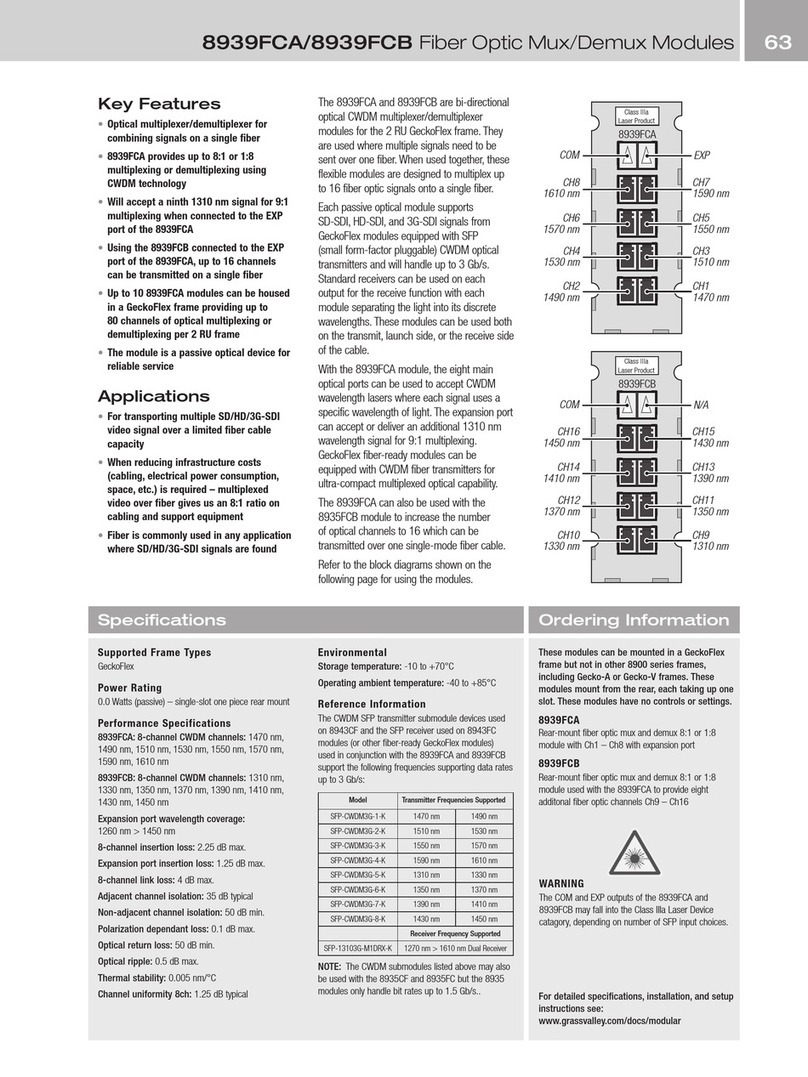
GRASS VALLEY
GRASS VALLEY 8939FCA User manual
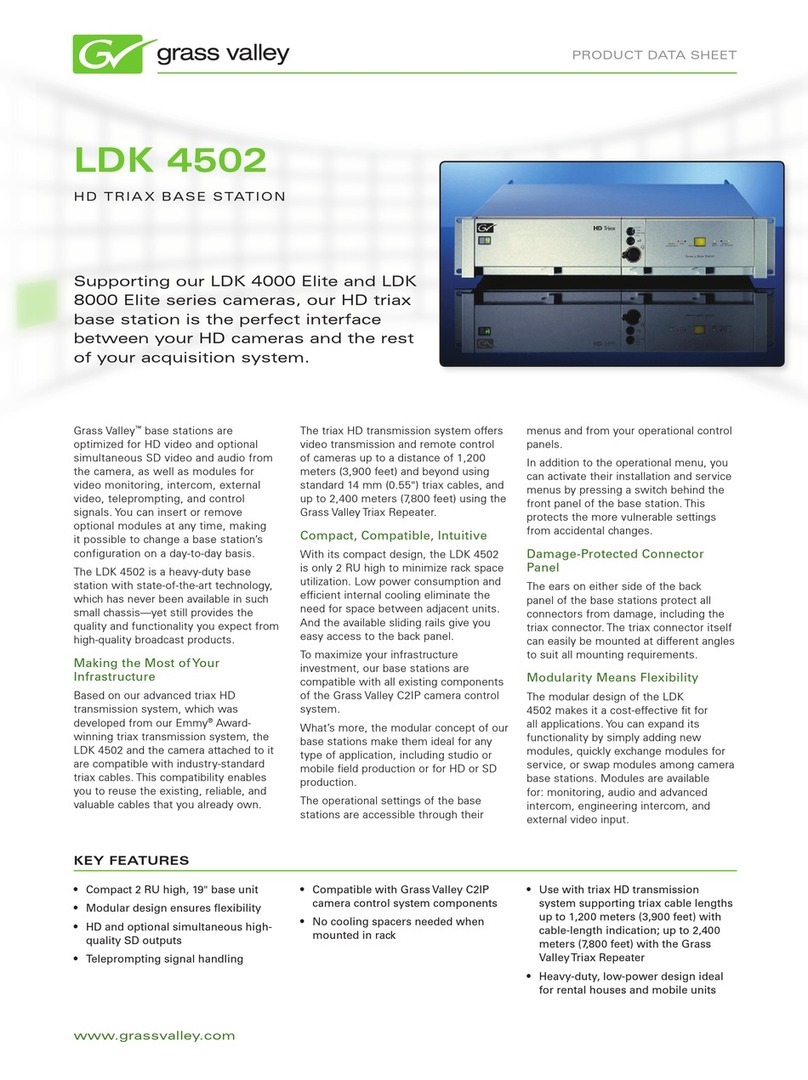
GRASS VALLEY
GRASS VALLEY LDK 4502 User manual
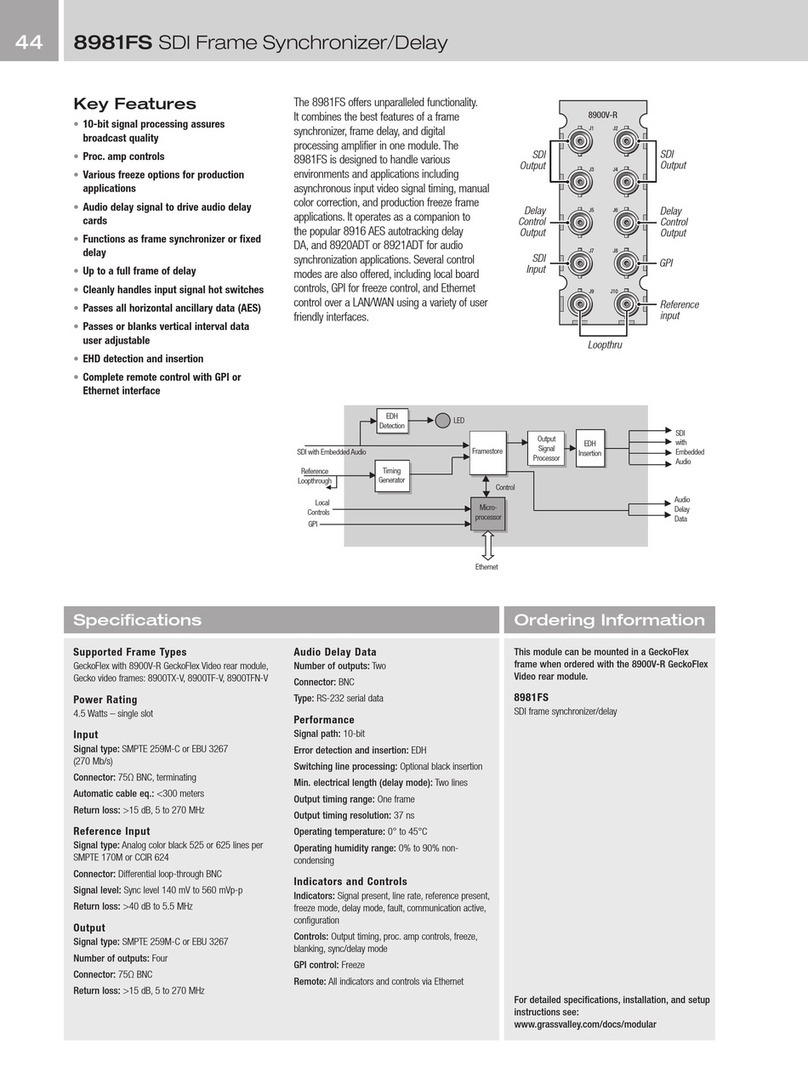
GRASS VALLEY
GRASS VALLEY 8981FS User manual
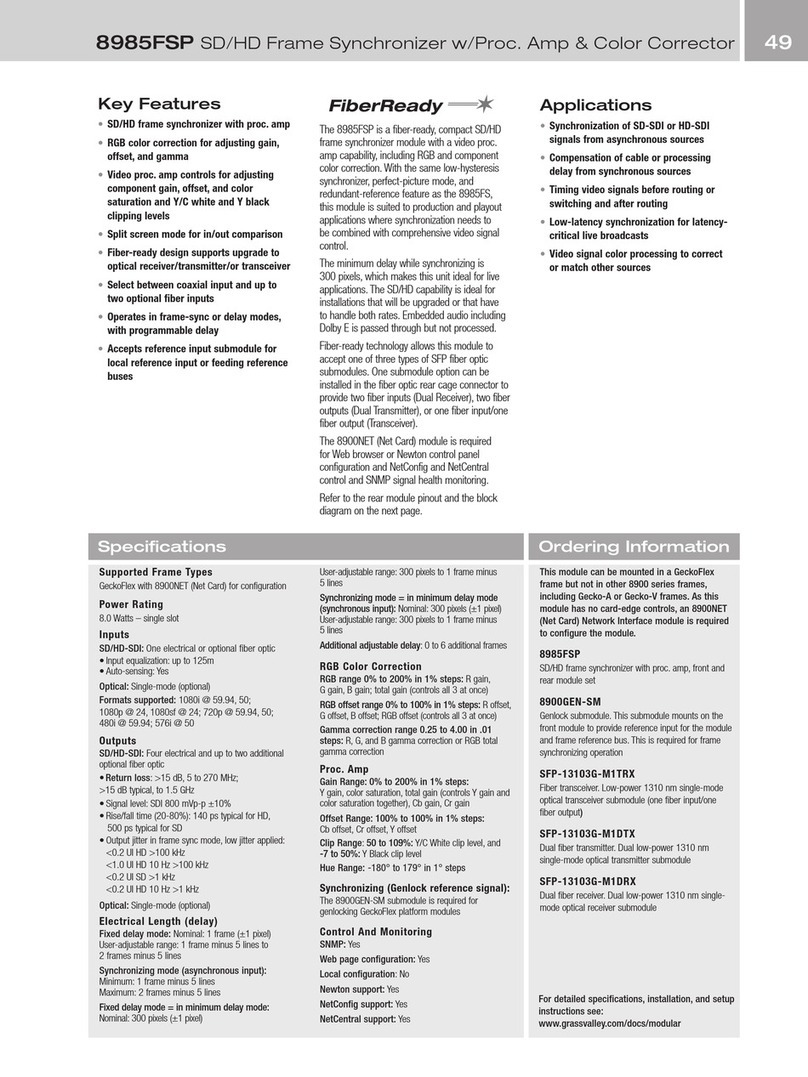
GRASS VALLEY
GRASS VALLEY 8985FSP User manual
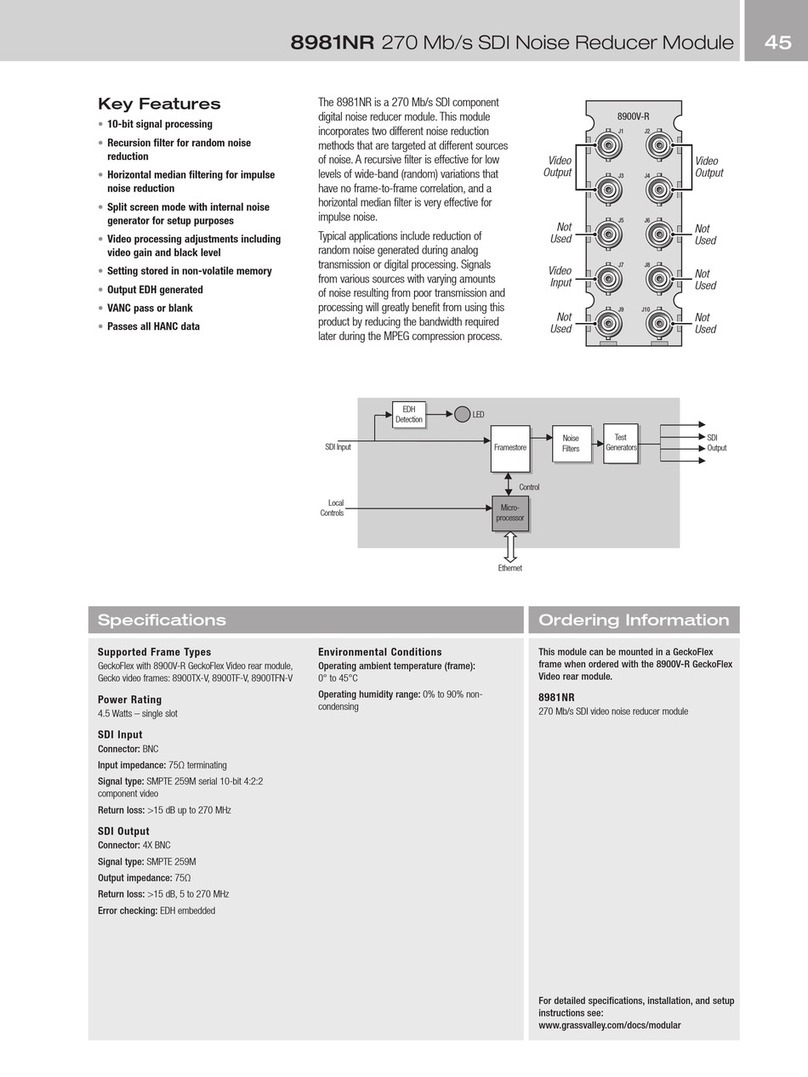
GRASS VALLEY
GRASS VALLEY 8981NR User manual
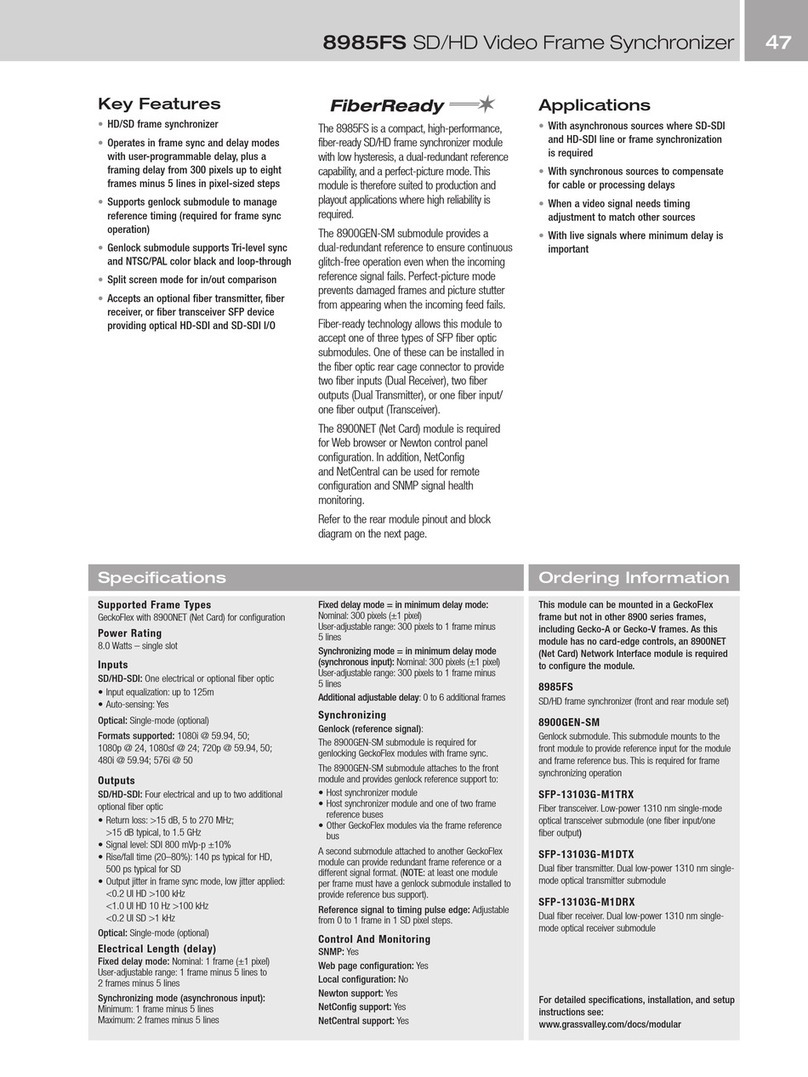
GRASS VALLEY
GRASS VALLEY 8985FS User manual
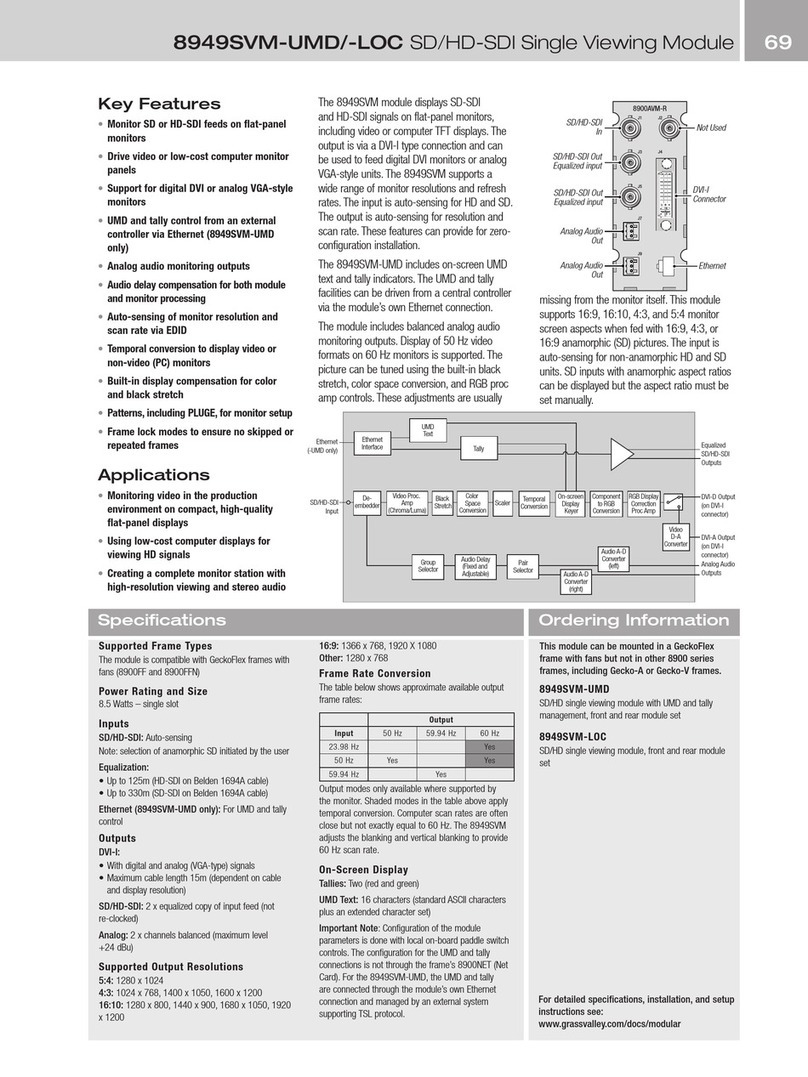
GRASS VALLEY
GRASS VALLEY 8949SVM-UMD User manual
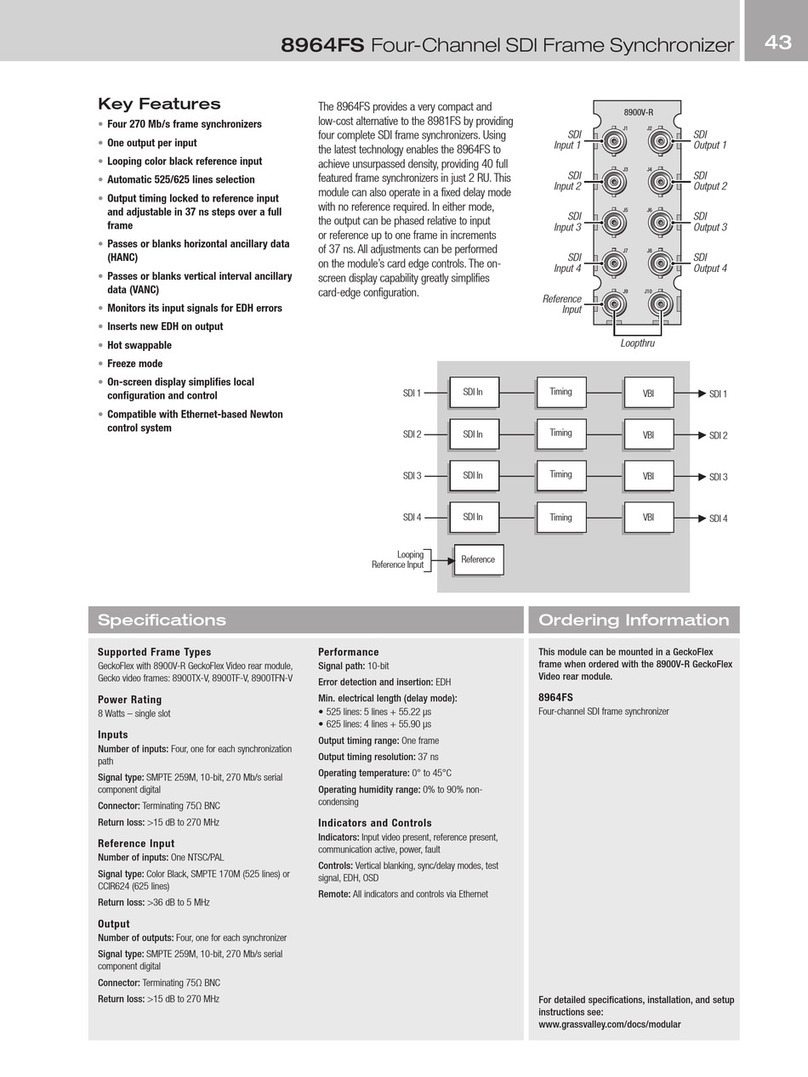
GRASS VALLEY
GRASS VALLEY 8964FS - User manual
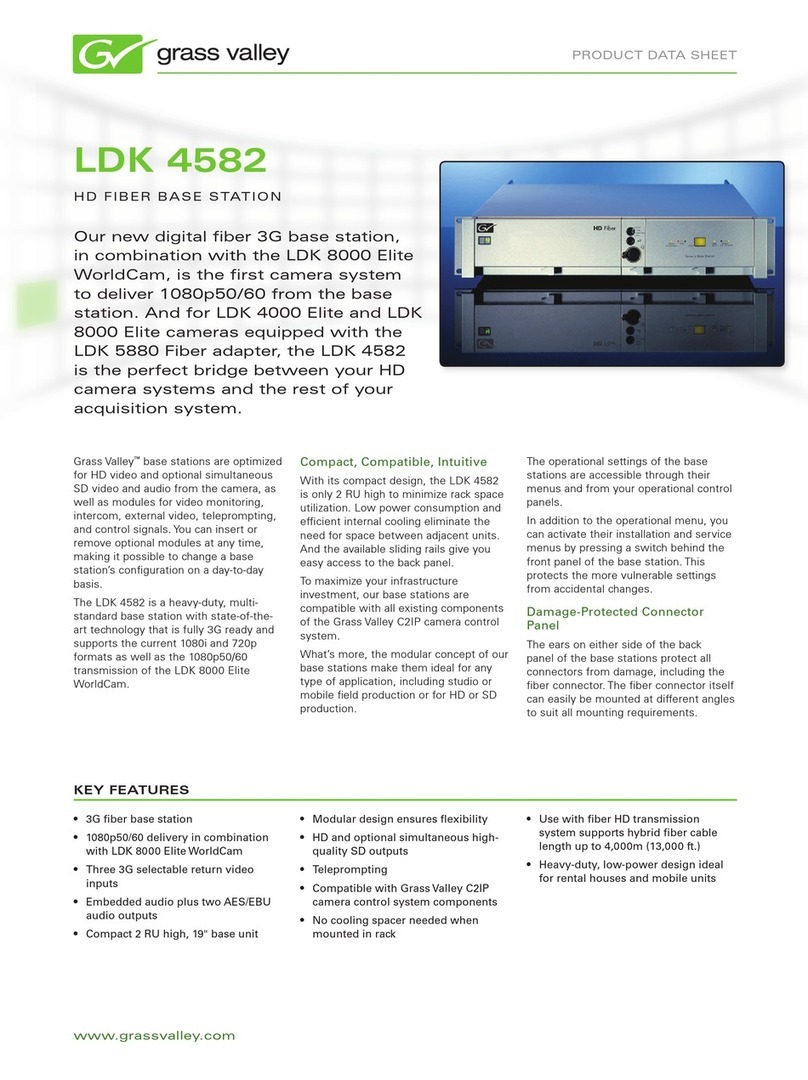
GRASS VALLEY
GRASS VALLEY LDK 4582 User manual

















